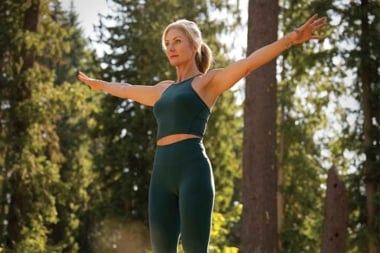
She's a race car driver ... and an environmental advocate on a mission.

How does Leilani manage to be both? Well, for starters: since 2007, she’s been adopting an acre of rainforest for every race she runs. Plus, her race cars have been emblazoned with bold messages about renewable energy and animal rights.
We tracked down Leilani to find out what drives her to protect animals and race really fast.
You’re an environmental advocate and a race car driver. Some may think that’s a strange combo—but explain why you’re taking this approach.
I can reach far more people through racing than I could as an environmentalist without a race car. Racing gives me a platform to talk about environmental issues and gives me access to 75 million race fans in the United States.
I do not believe in preaching to the choir. Whenever I speak at an environmental conference, it’s great to have people agree with me—but I’m not creating change. If we only speak to those who believe in the same things we do, who’s going to change the minds of those who don’t?
How long have you been racing professionally? What got you into it?
I’ve been racing for 16 years now. It was a bucket list item to go to a racing school, and I ended up being the fastest car on the track. A local race team owner was watching and encouraged me to pursue racing professionally.
The Academy Award-winning documentary The Cove was featured on one of your cars. Why was that important to you?
As soon as I saw The Cove, I knew I wanted to be a volunteer for Ric O’Barry’s Dolphin Project and help put an end to the senseless slaughter of dolphins in Taiji, Japan. Eight months later, I was on a plane to Japan to meet with [longtime] Ric O’Barry. He’s an amazing person and one of my personal heroes.
Since then, I’ve made several trips to Taiji as a volunteer to keep the issue in the public eye. The Cove awareness car that I raced at Daytona was funded purely by fans of the film. Our crowdfunding campaign got donations from all over the world.
You’ve also promoted the documentary Blackfish [about]. Why are you passionate about the sea and its life?
I wanted to do a Blackfish car in the same way I did The Cove car—to raise awareness about the film. When people see these documentaries, they are forever changed and may never support sea parks or dolphin and orca shows again.
When racing, you reach incredible speeds* while driving only inches from the car in front of you. How do you deal with fear? Do you do any mental training?
If I was afraid, I wouldn’t be able to race. I think the day I’m afraid is the day I hang up my helmet. That’s not to say that when I hug my husband and family and strap into my car, I don’t think it’s possible something could go horribly wrong on the track. But there’s a very, very small chance of that. These cars are incredibly safe.
Mentally, I’ve always been very good at focusing and tuning out the world around me. That’s what happens when I get in the race car—the whole world disappears. Race day is hectic: There are media, sponsors, fans, family and friends, and you’re being pulled in 50 different directions all day. That’s just part of the job. But when my helmet goes on, all of that disappears. It’s just me and the race car and the track.
I do train physically for the races. For instance, right now I’m doing 30 hot yoga classes in two months. I also do occasional juice fasts and feel great when I do them. In fact, I’m on day two of a 10-day juice fast right now.
*How fast?
“My top speed was in the Indy Pro Series with entry speeds of 205 miles per hour (mph),” says Leilani. “But with the cars I’m driving now, the top speed is probably 195 mph.” Oh, just 195 mph? No big deal.
You’re vegan—for how long have you eaten this way?
I’ve been vegetarian since I was a little girl, but I went vegan in the summer of 2011.
What made you start eating this way?
I love animals, and it disturbs me to no end to see how they are treated [by]. If I can live without killing any animals for my meals, why wouldn’t I? That’s my number one reason. Number two would be that a vegan diet has much less impact on the environment. Lastly is my personal health. For me, the health benefits are a happy side effect—my real reason for eating vegan is for the animals.

Do you have any tips or tricks for eating well while on the road?
I love using an app called HappyCow to find vegan places to eat. We even found places that were vegan friendly in Belize through HappyCow; it works all over the world. I love trying new vegan places, and there are more and more of them out there every day.
Do you have any tips for aspiring race car drivers? What should they know if they want to get into the sport?
It’s a tough sport, for sure. You have to work your way up the ladder, and it’s not an easy journey. It’s a very expensive sport. If you don’t have your own funds, you’ll have to pound the pavement to find sponsorship and bring value to those sponsors like I did.
Inside a vegan racing chick’s kitchen
“I think that if you trust your body, it will tell you what it needs,” says Leilani. She keeps her kitchen stocked with these staples:
- fruits and veggies
- pasta and rice
- meat substitutes like veggie burgers and vegan sausages
- vegan mac and cheese
- vegan ice cream
“It’s not like I live on kale and quinoa, though I do eat those foods,” she adds. “I eat all kinds of vegan foods—healthy and not so healthy.”
You’re in a documentary called Racing Extinction. Can you tell us about that?
Racing Extinction is a documentary I worked on for three years with the Oceanic Preservation Society (OPS), the makers of The Cove. This next film is about the sixth mass extinction, which we’re currently living through. Scientists estimate that we’re currently losing 30,000 species a year.
In Racing Extinction, the OPS uses covert operations to expose dangers to wildlife around the world. I’m the driver of the undercover getaway vehicle, which is a sort of James Bond version of a Tesla Model S. It has a 15,000 lumen projector that comes out of the back of the car, a FLIR (forward-looking infrared) camera that comes out of the frunk (front trunk) and electroluminescent paint—so with the flip of a switch, the car can light up like a bioluminescent ocean creature. It’s an amazing car.
I always wanted to be a Bond girl, and in this movie, I’m getting to live out that fantasy!

Tell me more about your new VegNation clothing line.
I’ve been working on this for a while. I love wearing clothes that have a vegan message on them—I’m an activist through and through. I think that just by walking around on the street, you have a chance to open someone’s mind by wearing [your] on your sleeve. So I decided to start my own line of vegan-themed clothes called VegNation. We’re starting out with some cool tees with fun messages, but eventually I hope it will be much more than that.
3 solid reasons to consider going vegan—for the environment
- 11x more fossil fuels are used to produce 1 calorie of animal protein compared to the same amount of plant protein.
- 1 lb of animal protein uses about 100 times more water than producing 1 lb of grain protein.
- 30% of the Earth’s land mass—about the size of Asia— is used for raising animals for food while 10% is devoted to grains, fruits and vegetables.
MAIN PHOTO BY Scott LePage





